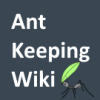The only natural mutations that actually change an organism usually result in death of the organism. In terms of a single ant colony evolving, that's not possible. You would need multiple ant colonies in proximity to each other to allow for evolution. (evolution that we can see with our eyes and record.) Evolutionary traits also MUST be passed onto its offspring. If the ant colony is isolated, there won't be offspring because alates won't fly. They also won't have anything to mate with,. Its impossible in isolated captivity.
Not all ants need nuptial flights, some ants do not even have winged alates. Especially the polygynous species (yellow crazy ants, black crazy ants, some Pheidole, some Solenopsis) can mate inside the nest, just gather a bunch of workers, walk a few hundred meters off and found a new nest (or even stay inside the nest they were born).
Also it is nonsense that all natural mutations result in death. We have dozens of bad mutations in our genome but most of them aren't even expressed unless two parents with the same mutation produce offspring which has the bad luck to get two damaged versions of the gene.
And while it is true that most mutations in the "biological BIOS" area (the areas that manage stuff like cellular core functions) are bad there's tons of areas where mutations slightly alter the shape of the offspring without significantly harming it. Who cares whether the workers of an ant colony are 2mm larger or smaller on average.
All arthropods have descended from segmented worms and the addition or loss (or switch) of a body segment is one of the most common "big" mutations (actually genetically it's a rather small one) in the arthropod realm that is still frequently happening today (and unless it's something like a wing or leg segment it usually doesn't have too much impact on the individual - who cares if an roach has an additional gaster or antenna segment).
Someone in the Discord ant chat apparently has a queen with a major head and while this may not be a favorable mutation under normal circumstances (it probably doesn't affect her ability to fly in a positive way) under the right environmental circumstances this might actually prove useful and lead to the emergence of a new species (where all queens have major heads).
I think that something very important to consider is that there are multiple theories of evolution and even the most mainstream / current one is still evolving (lol). Natural selection is definitely the most popular however nowadays more and more of the scientific community is pushing acceptance of an "evolutionary developmental theory" (or evo-devo as we called it in Bio class), which basically states that changes in generations are the result of individual change (not just population change). I believe there is also some argument for an "extended evolutionary synthesis" theory which accounts for non-genetic inheritance.
It's just something to keep in mind.
There is only one basic theory of evolution but the thing is the matter is vastly more complicated than that.
There's stuff like epigenetics (environmental cues lead to the expression of different genes within an individual and these changes are passed on to it's offspring), the red queen hypothesis (in evolution you have to run as fast as you can, all the time, to keep up - this is especially true for parasite-host-interactions), horizontal gene transfer (a good part of our genes are not even from our own realm but from fungus or plants and were transferred by viruses ignoring all realm borders), DNA transfer between symbionts and hosts (or mitochondria have very reduced genetics and part of what can be traced back to them is actually located in our own cell core DNA), etc. etc.
The fact that our traditional term of a species has been utterly smashed to pieces during the last years doesn't help (lots of animals that belong to clearly distinctive species can actually interbreed in times of necessity, like when El Nino devastated the Darwin finch populations their species boarders completely vanished and essentially every finch was able to breed with any other finch regardless of species borders, same happened to the Victoria Sea perches, also some birds from Europe can interbreed with their western Asian (and eastern American) counterparts but not with the eastern Asian (or western American) counterparts (which however can interbreed with the western Asian and the western American counterparts) - there's bird macrospecies that span the entire world like this, turning our traditional description of a species to a complete joke.
And let's not forget organisms which look exactly the same but actually belong to different "species" (in the sense that they do not interbreed) that can only be distinguished by genetic analysis (like all the various subspecies of Tetramorium - where we can't even be sure if some of them are actually different species or just local variations). They don't make things easier either.
Edited by Serafine, March 11 2017 - 2:49 AM.


















